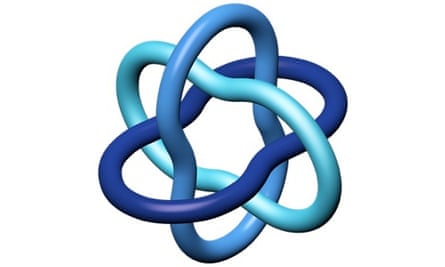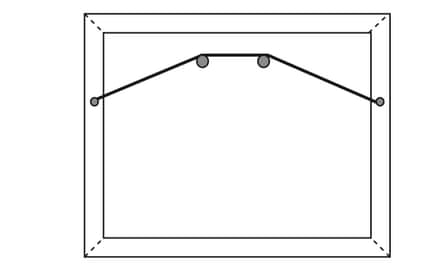The image above is the Borromean rings, three interlinked rings that have the curious property that when any one of the rings is removed, the other two are no longer linked.
The rings are studied by mathematicians and have long been used as a metaphor for the interdependence of three parts, since either all three are linked, or none are. (The name comes from the Borromeo family of Renaissance Italy, which had the pattern on their coat of arms.)
You cannot make a physical version of the Borromean rings with three perfect circles as illustrated above, but you can if you bend the circles slightly out of shape, or if you use non-circular loops. The global scientific body for maths, the International Mathematical Union, has a 3-D version of the Borromean rings as its logo, below. (The IMU is celebrating its centennial this month, about which more later.)

Now for today’s puzzle, which riffs on the idea of the Borromean rings: it involves three linked elements that fall apart completely when only one element is removed.
Smash the picture
The picture below shows the conventional way to hang a picture on a wall with two nails. The two nails give each other back-up: if one fails, the picture will still hang (wonkily) on the other nail.

Can you think of a way to hang a picture on a wall using string and two nails, such that if either of the nails fails (and the other one doesn’t) then the picture will fall to the floor?
This is a puzzle that is quite hard to visualise, so I would recommend playing around with nails and a piece of string. If you dont have any nails at hand, maybe use some rings.
I’ll be back at 5pm with the solution.
PLEASE NO SPOILERS. If you are struggling, however, please ask questions below.
UPDATE: To read the solution(s) click here.
The International Mathematical Union was founded in 1920 to promote international cooperation in maths. It also organises the four-yearly International Congress of Mathematicians, and awards the Fields Medals, which are maths’ most prestigious prize.
The IMU was founded in the Palais Universitaire in Strasbourg, which is the same location where its centennial will be held on September 27 and 28. (The event was rescheduled from last year due to Covid.) The programme features talks by 17 of the world’s top mathematicians and will be broadcast live: a must-watch event if you are interested in hearing about the current frontiers of mathematical research.
I set a puzzle here every two weeks on a Monday. I’m always on the look-out for great puzzles. If you would like to suggest one, email me.
I’m the author of several books of puzzles, most recently the Language Lover’s Puzzle Book. I also give school talks about maths and puzzles (restrictions allowing). If your school is interested please get in touch.

Comments (…)
Sign in or create your Guardian account to join the discussion